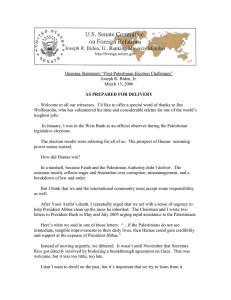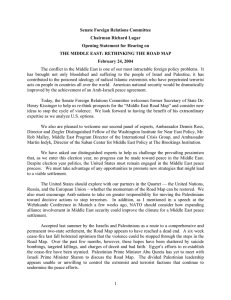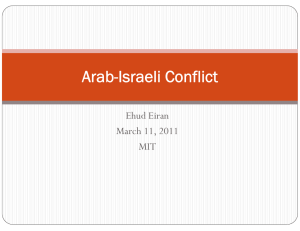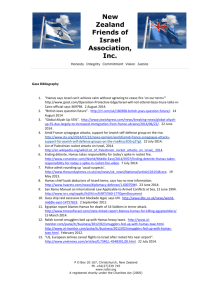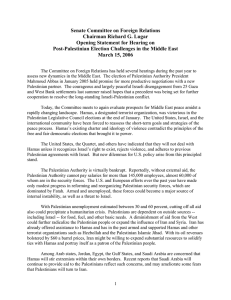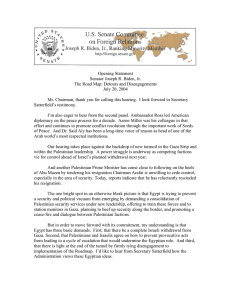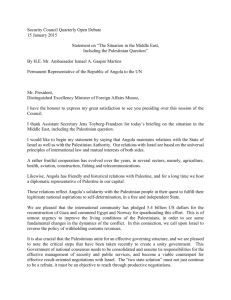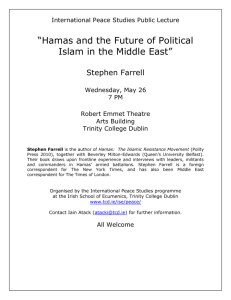Middle East Brief Brandeis University Crown Center
advertisement
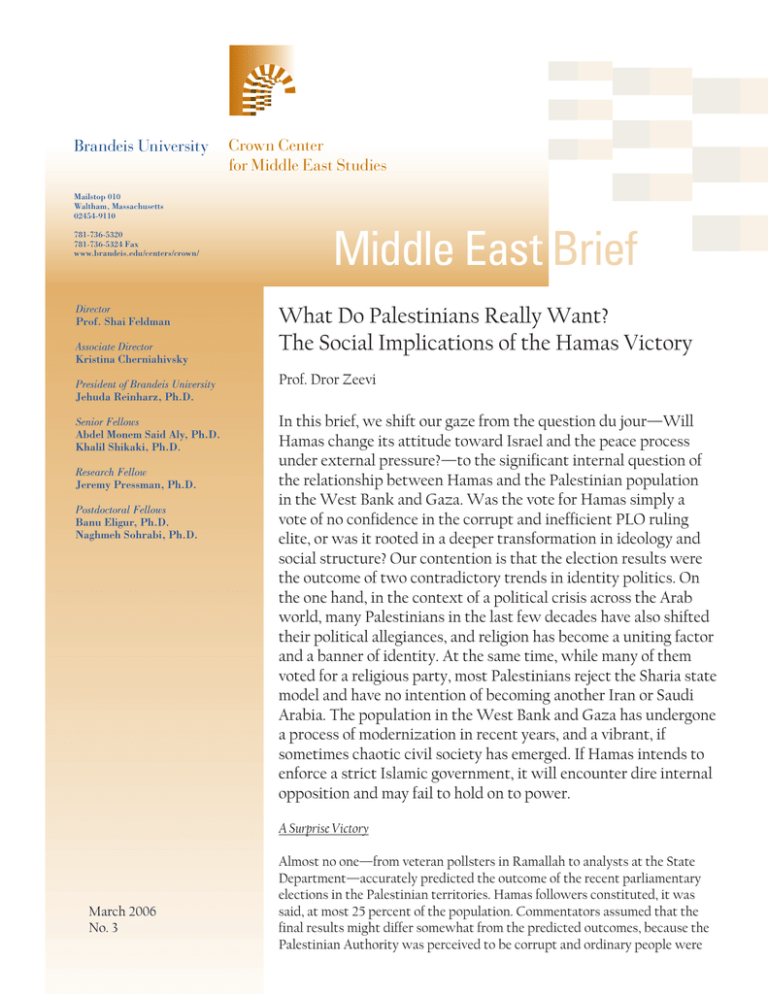
Brandeis University Mailstop 010 Waltham, Massachusetts 02454-9110 781-736-5320 781-736-5324 Fax www.brandeis.edu/centers/crown/ Crown Center for Middle East Studies Middle East Brief What Do Palestinians Really Want? The Social Implications of the Hamas Victory Prof. Dror Zeevi In this brief, we shift our gaze from the question du jour—Will Hamas change its attitude toward Israel and the peace process under external pressure?—to the significant internal question of the relationship between Hamas and the Palestinian population in the West Bank and Gaza. Was the vote for Hamas simply a vote of no confidence in the corrupt and inefficient PLO ruling elite, or was it rooted in a deeper transformation in ideology and social structure? Our contention is that the election results were the outcome of two contradictory trends in identity politics. On the one hand, in the context of a political crisis across the Arab world, many Palestinians in the last few decades have also shifted their political allegiances, and religion has become a uniting factor and a banner of identity. At the same time, while many of them voted for a religious party, most Palestinians reject the Sharia state model and have no intention of becoming another Iran or Saudi Arabia. The population in the West Bank and Gaza has undergone a process of modernization in recent years, and a vibrant, if sometimes chaotic civil society has emerged. If Hamas intends to enforce a strict Islamic government, it will encounter dire internal opposition and may fail to hold on to power. A Surprise Victory March 2006 No. 3 Almost no one—from veteran pollsters in Ramallah to analysts at the State Department—accurately predicted the outcome of the recent parliamentary elections in the Palestinian territories. Hamas followers constituted, it was said, at most 25 percent of the population. Commentators assumed that the final results might differ somewhat from the predicted outcomes, because the Palestinian Authority was perceived to be corrupt and ordinary people were dissatisfied with the functioning of its institutions and services; Palestinians, it was remarked, were also tired of anarchy, and of the gangs of armed warlords roaming the streets. All this, analysts assumed, would probably chip away at the expected Fateh majority and give Hamas a higher than anticipated percentage of the vote, but it was thought very unlikely that the Palestinian president, Mahmoud Abbas (Abu Mazen), and his party would lose control.1 The failure to predict the outcome of the elections was attributed to many factors, including a larger voter turnout than expected, the failure of the Fateh Party to run an effective campaign, divisions within Fateh (it was pointed out, for instance, that in many districts two or more Fateh candidates ran against one Hamas candidate, so that Fateh votes were divided), and the continuation of targeted assassinations by Israel, which led voters to punish it through their choice of candidates.2 All these factors, however, disregard a series of long-term shifts in the Palestinian state of mind, which made the Hamas victory possible. Dror Zeevi is a professor at Ben Gurion University in Israel, where he founded the Department of Middle East Studies, and a Visiting Scholar at the Crown Center for Middle East Studies. When the results of the elections became known—Hamas, or, as it is officially called, the Change and Reform Party, won 74 out of 132 seats in Parliament, a clear and resounding victory—most analysts, still in the grip of their former assessments, claimed that this majority was not an indication of a deep-seated identification with the ideology and religious dogma of the winners. They defined it, rather, as a vote of no confidence in the previous political elite and, in particular, of dissatisfaction with the widespread corruption in the group of Fateh top brass often defined as “the newcomers”: the group of leaders who entered the Palestinian territories after the Oslo Accords and were invited by Israel to take over the government of the West Bank and Gaza.3 This claim does not explain, however, why the Palestinians did not vote in great numbers for the younger generation of Fateh leaders. Candidates supported by those who emerged as popular leaders during the first and second intifadas—among them people such as Jibril Rajoub, leader of a major Palestinian security service, and Marwan Barghouti, the most popular young Fateh leader, who is currently serving a prison sentence in Israel—failed to win election in greater numbers. It also fails to explain why other, nonreligious parties, such as the “Third Way,” led by the former successful finance minister Salam Fayyad, or “The Alternative,” headed by wellknown activists, failed to get a larger share of the vote. Although all of the factors mentioned above certainly had an influence on voters, it appears that the vote for Hamas was not motivated solely by disappointment with the Palestinian Authority and the desire to punish the previous corrupt leadership, but also by a deeper shift in ideology. From Arabism to Arab-Islamism In order to understand this shift, we should direct our attention to several long-term developments in the Arab world, and to their implications for Palestinians. These include the decline of secular pan-Arab nationalism, the rise of nationalist-religious tendencies, and the incremental impact of Hamas’s religious campaign, which is propagated by its mosque-based da`wa (the Hamas branch in charge of both social welfare and the dissemination of Islam) and its publications arm, A`lām. Secular Arab nationalism has been on the decline for decades. Despite the high expectations which accompanied the officers’ revolutions and military coups of the 1950s, secular regimes such as Nasserist Egypt and Baathist Iraq and Syria proved militarily impotent, economically incompetent, and just as corrupt as the previous colonialist monarchies and republics. For a time Arab nationalist feeling itself was on the decline, and localized nationalist ideologies—Iraqi, Jordanian, Syrian, Egyptian—filled the void. But although local nationalisms did take root in much of the Arab world, a series of concurrent events had complicated the scene.4 First and foremost among these events were the Gulf War (1991) and the current Iraq War (beginning in 2003). Seemingly, both wars against the Iraqi dictator broke the ranks of the Arab world and increased its fragmentation. In 1991, Egypt and Syria aligned themselves with the American-led coalition, while Jordan and the Palestinians supported the Iraqis. With respect to the current hostilities, most Arab governments have done their best to stay away from full commitment to either side; but while Jordan, Saudi Arabia, and the Gulf States officially supported the United States in its invasion of Iraq, other governments kept their distance. At the regime level these opposed alignments led to a further breakdown in unity, and gave the impression that (pan-)Arab nationalism had practically disappeared. Among many ordinary Arabs, however, they served as a catalyst for a renewed sense of common destiny. While their local patriotisms may have remained intact, people in the Arab world are also united today in their opposition to the United States role in the region, which most interpret mainly as a war waged against Islam. Disappointed by previous colonialist attempts to emulate the West in the first half of the twentieth century, and then by explicitly secular pan-Arab regimes, in the last two decades they became more and more attracted to ideologies with an Islamic hue that defied the West and offered new and untested solutions to internal weakness. As their government fluctuated between support and condemnation of the United States, many Palestinians also felt a sense of kinship with their brethren in the Arab world, an alienation from their government, and a renewed sense of religious pride. This tendency was compounded by two other interconnected developments: the rise of Arab satellite TV, and the second Palestinian uprising (2000–2004). Aljazeerah, Al-Arabiyya, and quite a few other Arab satellite networks, some of them openly religious, appeared on the scene in the 1990s, further boosting the feeling of Arab-Islamic unity. Exploiting the huge market of Arabic speakers from the Atlantic Ocean to the Gulf, the new networks brought together Moroccans and Iraqis, Syrians and Sudanese, and focused on developments in the Arab world. In many ways these networks are a positive development, undermining the censorship and taboos enforced by regimes across the Middle East and offering an arena for open debate. No less significant, however, is the fact that alongside talk shows and so-called reality shows—such as the local version of “American Idol,” in which young singers from around the Arabicspeaking world participated—they also often offer religious programs, such as the immensely popular one on Aljazeerah featuring Sheikh Yusuf al-Qaradawi, an Islamic cleric who offers Islamic interpretations and guidance with respect to modern life situations. Intense satellite media coverage of Israeli violence in the Palestinian territories and of American military actions in Afghanistan and Somalia, presented with little censorship and hostile commentary, reinforced the sense of suffering and shared destiny among the population of the Arab world. The events following 9/11 and the wave of perceived hostility toward Islam in the West, which culminated in the invasion of Iraq, entrenched these feelings. While Arab governments moved further apart from each other, their populations found themselves reunited by a new sense of purpose. This unity is very different from the first wave of panArabism in the mid-twentieth century. Distrustful of their governments’ superficial secularism, united by a sense of religious indignation born out of the perception of Western siege, and buoyed by the eschatological promises of religious scholars, many Arabs, and the majority of Palestinians, are now united not in Arabism, but in ArabIslamism.5 The Appeal of Islam Governments in the area caught on to this trend and tried to exploit it for their own needs. As early as 1991, Saddam Hussein redesigned the Iraqi flag, adding the slogan “God is Great” (Allahu Akbar) to the republican red, white, and black. Other leaders followed suit. Yasser Arafat’s overtly religious discourse—and his appeals for martyrdom on the road to Jerusalem, couched in Islamic terminology—were another manifestation of Arab-Islamism. And although he no longer uses the same terminology, the current president, Mahmoud Abbas, and his ministers regularly attend televised public prayers on Fridays, just as his predecessor used to do. Thus, for Palestinians, as for other Arabs, it was no longer a choice between secular ideology and religion. That choice had been made some time ago. For most voters, the Palestinian elections were actually a choice between hypocritical leaders, who paid lip service to religion but were seen as insincere Muslims, on top of being corrupt and inefficient, and an Islamist party which actually practiced what it preached, was relatively uncorrupt, and could boast some success in its struggle against Israeli occupation. Although conditions in Iraq, Egypt, and Jordan are markedly different, the same trend can be seen operating in those countries as well. ___________________________________________________________________________________________ “There is no God but Allah, and Muhammad is His messenger” on the Palestinian flag incorporated into Hamas Emblem (left) Another factor that contributed to the incremental rise in support for Hamas was the success of its own social work and religious sermonizing. Throughout the last fifteen years Hamas has built an extensive social welfare network that includes furnishing monetary allocations to poor families, operating day care centers and kindergartens, and providing extracurricular activities for women and children in the mosque after school hours. While alleviating some of the burdens for large families on small budgets, these activities also introduced women and youth (who are often underrepresented in surveys and opinion polls) to an orthodox religious perspective in all these frameworks. School education, which under the previous administration was reverential to religion yet ambiguous about its implementation, was infused with a much stronger commitment to religion. Women, students, and the younger generation in the Palestinian territories today are therefore more likely to support a system with a clear religious orientation. In fact, as exit polls from the last elections demonstrate, women and students voted for Hamas in great numbers, and they may have been the foundation of the Hamas victory.6 Palestinian boys in a Hamas summer camp (left) Palestinian girls carrying pictures of Shaykh Ahmad Yassin, the founder of Hamas (right) The Task for Hamas Although a majority of Palestinians opted for “real” Islam over a diluted version, it seems that they got more than they bargained for. The type of religious sentiment that has become prevalent in much of the Arab world, including among Palestinians, is very different in its premises from the one propagated by Hamas or by its forebear, the Muslim Brotherhood. It is more a rallying cry, to a cause that is easily identifiable, than a true wish to return to the rigid religious precepts of Wahhabi orthodoxy.7 On the whole, Palestinians are at present better educated than most inhabitants of the Arab world. Many have access to modern media and technology, and enjoy modern consumption patterns. Palestinian women, partly as a result of their participation in the two uprisings, now enjoy greater access to the public sphere than in some neighboring states. The number of Palestinian women in higher education is growing rapidly; some have joined government ministries and achieved high status. Furthermore, at least until the last cycle of violence, Palestinians in the West Bank and Gaza have had close relations with Israeli Palestinians, who all in all hold very different views on religion. Palestinians in Israel traditionally vote for a wide array of mostly secular parties; although religious parties have grown in recent years, they still represent a minority of Palestinian Israeli voters. Visiting their families and watching Arabic and Hebrew programs on Israeli television, Palestinians in the West Bank and Gaza became acquainted with the boisterous quality of the neighboring Arab civil society. For most Palestinians, religion is a compound of traditional stances and modern attitudes. People may well declare their support for the Shari`a (Islamic law) as the sole legitimate source of legislation, pray at a mosque on Friday once in a while, and fast at Ramadan, but at the same time they watch video clips of scantily dressed pop singer Haifa Wahbi; enjoy the daily Egyptian or South American soap opera on TV, and may even take a sip of beer at the end of a rough day. While many would take pride in the establishment of an Islamic government, the majority would thus not be favorable to measures that would curtail women’s liberties, enforce the veil, segregate higher education, or limit women’s access to the public sphere. Furthermore, Palestinians have gone through a process of politicization that few other Arab publics have experienced.8 Civil society in the West Bank and Gaza is visible and vocal, and with global media following closely, the chances of an Islamic dictatorship taking root are slim. Even if it attempts to do so, Hamas will fail to indefinitely postpone elections or to henceforth bar the entrance of secular parties into the political arena, as Iran has done. The Palestinian elections will not be remembered as a “one person, one vote, one time” situation. The expectations that the Palestinian population have of their religious government—of an honest, efficient administration which, though adhering to Islamic principles, would be neither dictatorial nor overly dogmatic—will also have a direct bearing on the way Hamas chooses to redefine itself as a ruling party, presumably somewhere between the two other readily available models of Islamic government: Turkey and Iran. Both these countries are ruled by parties that are manifestly religious, but while Turkey’s ruling Justice and Development Party (AKP) has made no attempt to fundamentally change Turkey’s secular constitution or the rules of the game, Iran’s religious rulers have totally altered the political sphere since the 1979 Revolution, banning secular political parties and candidates, changing the constitution and the legal system, and relegating ultimate decision making to a board of religious clerics. Hamas, for its part, is a far cry from Turkey’s Justice and Development Party. It has not willingly embraced the rules of the democratic game and sees it as an imposition from the outside; it seeks to implement the Shari`a as state law; and it lacks the perspective of a state with an old, entrenched secular constitution that Turkey has. In that respect it identifies more closely with the Iranian model, and will probably try throughout its first term in office to implement laws inspired by religion as it interprets it. expectations and realities. It has to answer to a constituency that is attuned to political freedoms9—The Palestinian Authority has, after all, held three successful election processes so far—and to contend with a still powerful PLO, led by the Fateh and Mahmoud Abbas, that will attempt to maintain control of many of the state’s official and semiofficial security organs. We should also bear in mind that the PLO has successfully represented the wishes and concerns of Palestinians for several decades, and despite its recent eclipse, is still held in high regard as a champion of the national cause. On top of all that, the Palestinian Authority has precious few independent sources of income and is totally dependent, economically, on the goodwill of external powers, most of which are reluctant to support a totalitarian Islamic regime. This puts the new Hamas leadership, ironically and notwithstanding its own predilections, in a position closer to that of the AKP in Turkey—an openly religious party that is forced to abide by democratic rules of the game. As in Turkey, this will require the Hamas government to play its cards carefully, not to be overly harsh in its application of religious principles, and to put its ideas to a real test of the voters’ will. Finally, although many Palestinians are in favor of a defiant stance against Israel’s heavy-handed policies, in the absence of a better alternative the majority would ultimately prefer some sort of temporary compromise that will enable them to enter Israel, find work, and visit their relatives. As things seem at this point in time, Hamas is reluctant to contemplate this alternative and would prefer a standoff in which trade and other relationships with Israel stagnate, but this may change when the new government is faced with the realities of economy and society. Thus, as its leaders are finding out on a daily basis, in the near future Hamas’s success will depend on its deportment in the internal arena. Attitudes toward Israel and the peace process will not have an immediate effect on its popular support base; in fact, an independent position vis-à-vis Israel will garner support for the new government and make it more popular in the short term, despite probable economic hardships. On the internal front, however, if the party attempts to pursue an “ideological” course of action, strictly adhering to its previously declared positions on society and religion, it may lose much of its constituency and will be voted out of power in the next elections or even earlier.10 If it adapts its policies to popular expectations with regard to such issues as women’s dress, segregated education, alcohol consumption, and public entertainment, then the Hamas government has a good chance of success. On the other hand, Hamas operates in a social and political sphere that has already been conditioned by certain (Endnotes) 1) Harvey Morris, Financial Times, Jan. 26, 2006. For Palestinian assessments see: Chairman of Fateh, Faruq Al-Qaddumi, interviewed by Aljazeerah on Jan, 23, 2006. For State Department assessments see: Martin Chulov, The Australian, Jan 31, 2006. Condoleeza Rice: ‘’I’ve asked why nobody saw it coming. It does say something about us not having a good enough pulse.’’ New York Times Quotation of the Day, Jan.30, 2006. These assessments were based mainly on extensive surveys and polls conducted over the years, notably by the Palestinian Center for Policy and Survey Reseach (PSR), headed by Professor Khalil Shikaki (http://www.pcpsr.org/survey/polls/2005/preelectionsdec05.html), but also by quite a few other individuals and groups (Professor Nader Said of Birzeit University’s Development Studies Program (http://home.birzeit. edu/dsp/), Al-Najah University in Nablus (http://www.miftah.org/Doc/Polls/PalestinianPublicOpinionPollsNo17.pdf), the Tami Steinmetz Center for Peace at Tel Aviv University (http://spirit.tau.ac.il/socant/peace/), Professor Mark Tessler and others of the University of Michigan (http://polisci.lsa.umich.edu/documents/tesslerCPArticle. pdf. Tessler, Mark A., “Gauging Arab Support for Democracy,” Journal of Democracy 16, no. 3 [July 2005]: 83–97.), and the Center for Strategic Studies at the University of Jordan, among others. All of the surveys were wide of the mark. Surveys conducted in the Palestinian territories are problematic, and the validity of their results as a tool for social and political analysis may be open to question. Given a complex set of external and internal circumstances—Israeli occupation, an absence of entrenched democratic traditions, subservience to family politics, and even a sense of politeness that subverts openness about political issues—such surveys are bound to be flawed. To illustrate the last point: In Turkey, a recent survey found that people responded to questions about religious stances differently when approached by pollsters dressed in clearly “secular” garb and by the same people wearing clothes that could be identified as Islamic (Tolga Köker, work in progress). 2) James Glanz, The New York Times, Feb. 19, 2006. 3) http://www.newyorker.com/printables/online/060227on_onlineonly01 4) The situation is slightly different from country to country. Egypt has always had a clear sense of its own particular nationalism. Iraq has developed strong internal ties (which are now being rapidly eroded). In Syria, Jordan, and Saudi Arabia, on the other hand, state-imposed nationalism has often been contested by other imagined communities. 5) http://www.css-jordan.org/new/REVISITINGTTHEARABSTREETReport.pdf. Check figure IV3 on page 51. 6) http://home.birzeit.edu/dsp/elections/Harvard.ppt#272,16,Voting for Hamas and Fateh. 7) Wahhabism is the Islamic ideology, based on the Hanbali school of Islamic law, that underpins the Saudi regime and is propagated by the Saudis throughout the Islamic world. 8) Iraq and Lebanon are two other notable examples of politicized Arab publics. 9) Ironically, the long period of social and political anarchy during the last uprising has also contributed to the rise of a politicized constituency in the Palestinian territories. 10) For example, the next presidential elections are slated for 2009, three years from now. If Hamas chooses to put forward its own candidate, these elections may turn out to be a confidence vote in the Hamas government.
